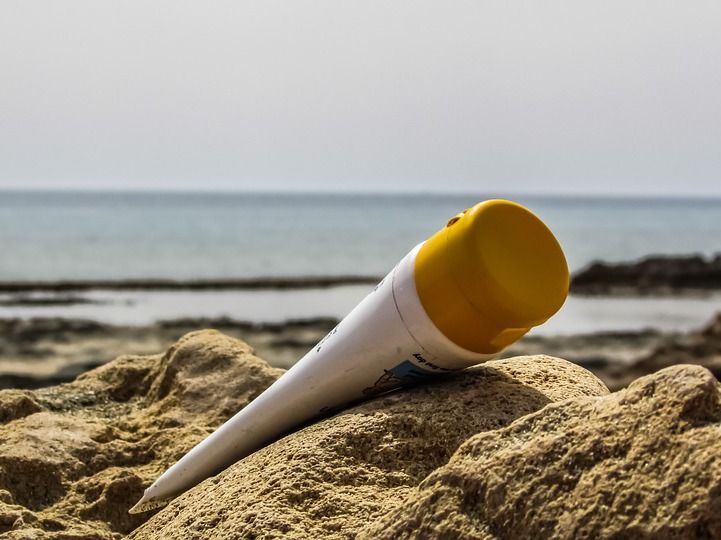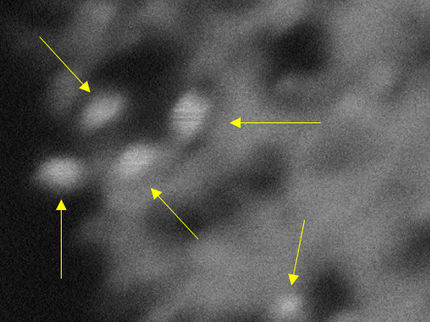Titanium dioxide from sunscreen is polluting beaches
Scientists have found that sunscreen from bathers releases significant quantities of polluting TiO2 (titanium dioxide) into the sea. This has the potential to harm marine life. This work, which comes from research on beaches in the South of France, was presented at the Goldschmidt geochemistry conference in Boston (see below).

Sunscreen at a beach, symbolic picture
dimitrisvetsikas1969; pixabay.com; CC0
TiO2 is one of the main ingredients of sunscreen, where it acts as a protective against harmful UV rays: most major regulatory bodies consider it generally safe for human use at the concentrations used in sunscreens, however, concentrated TiO2 or long term exposure could be toxic to a variety of fish and other aquatic organisms.
In many sunscreens, TiO2 is present as tiny nanoparticles, which are coated with protective chemicals. Because the particle size is so small, nano-titanium dioxide does not reflect visible light, but does absorb UV light, enabling a transparent barrier that protects the skin from the sun's harmful rays.
The researchers have found that in water, the nanoparticles tend to lose their protective coating under the influence of UV light or seawater composition, which exposes the more toxic TiO2 to the aquatic environment.
They measured TiO2 concentrations in 3 beaches near Marseille in France, as well as surveying bathers about how much they used sunscreen, and how often they used the water. The team found daily concentrations of 15 to 45 μg/L of TiO2, which corresponds to several kg of nanoparticles per summer season per beach.
Lead Researcher, Dr Jérôme Labille (Labex Serenade / Aix-Marseille Université / CNRS, Aix en Provence, France) said:
"For example, with one small beach which held around 3000 people daily, we calculate that around 68kg of cream could be deposited per day, or 2.2 tons over the height of summer. If we consider reasonably that half of the creams used contain 5% of titanium dioxide, this gives 1.7 kg of titanium dioxide released per day: That comes to around 54kg in the two months of high summer, which is a significant amount. Of course, the sea is more or less continually in motion, so some of the titanium dioxide pollution will be dispersed. Nevertheless, we anticipate an accumulation of titanium dioxide in the seashore littoral, which could affect the wildlife there. In recreation areas with stagnant water, such as in lakes or seawater swimming pools, then there will be no such dispersion and the accumulation would be expected to be even more pronounced.
It is important to keep this in perspective; titanium dioxide is a pollutant, and we need to take measures to try to reduce the quantities of TiO2 which are concentrated in the aquatic environment, where it can be harmful to fish and other organisms. Nevertheless, it is extremely important that sunbathers continue to use sunscreen for skin protection, the titanium dioxide pollution needs to be dealt with by the manufacturers and possibly legislation, and we've had good feedback from the manufacturers we are working with".
The researchers note that in early July of this year, Hawaii banned certain sunscreens which were found to be harming coral reefs (this was not due to titanium dioxide)-
Dr Labille continued, "The good news is that we are working on nanoparticle UV filters and sunscreen formulations which will reduce the potential damage from titanium dioxide. We're looking at developing sunscreens which are "safe by design" in which the release and toxicity of nanoparticles will be minimized, so we anticipate that a solution to this problem isn't too far away".
Other news from the department science
These products might interest you

NANOPHOX CS by Sympatec
Particle size analysis in the nano range: Analyzing high concentrations with ease
Reliable results without time-consuming sample preparation

Eclipse by Wyatt Technology
FFF-MALS system for separation and characterization of macromolecules and nanoparticles
The latest and most innovative FFF system designed for highest usability, robustness and data quality

DynaPro Plate Reader III by Wyatt Technology
Screening of biopharmaceuticals and proteins with high-throughput dynamic light scattering (DLS)
Efficiently characterize your sample quality and stability from lead discovery to quality control

Get the chemical industry in your inbox
By submitting this form you agree that LUMITOS AG will send you the newsletter(s) selected above by email. Your data will not be passed on to third parties. Your data will be stored and processed in accordance with our data protection regulations. LUMITOS may contact you by email for the purpose of advertising or market and opinion surveys. You can revoke your consent at any time without giving reasons to LUMITOS AG, Ernst-Augustin-Str. 2, 12489 Berlin, Germany or by e-mail at revoke@lumitos.com with effect for the future. In addition, each email contains a link to unsubscribe from the corresponding newsletter.




























































